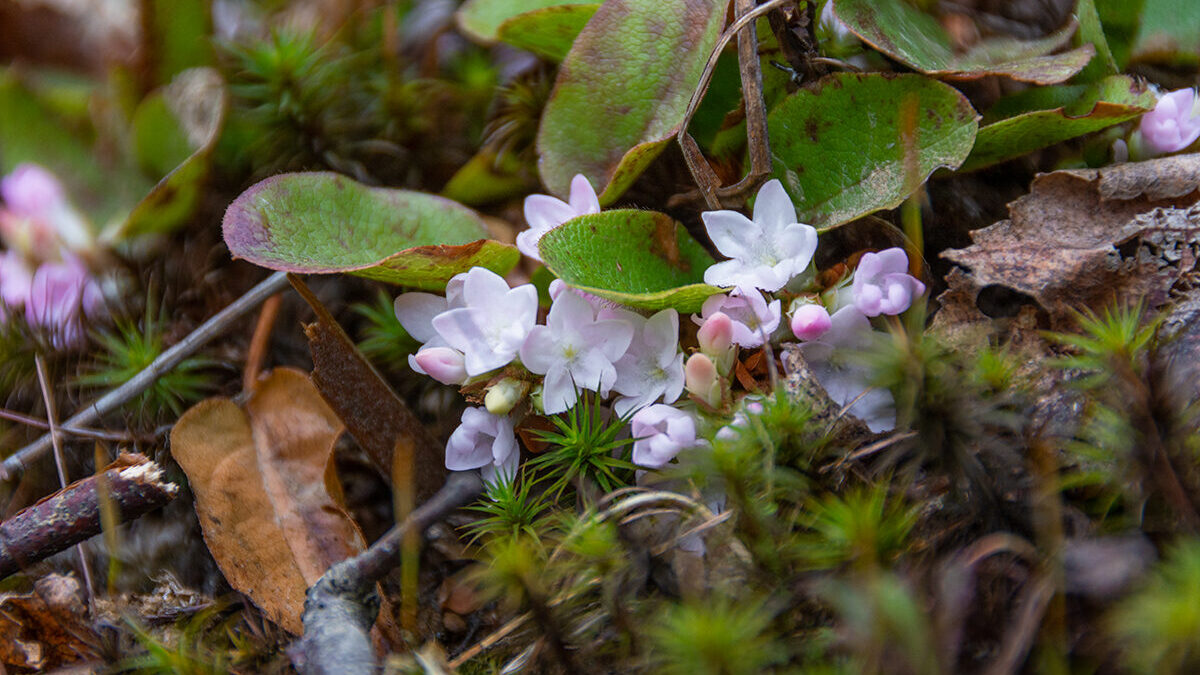Mayflowers (Epigaea repens) are one of my favourite wildflowers. When I was a child, they grew in abundance near my home. There were so many that we could smell them long before seeing them. My brother and I would harvest small aromatic bouquets for my mom, who displayed them proudly on a windowsill.
Here in the Atlantic provinces, mayflowers are one of the first signs of spring. You can find them growing as early as April, often alongside the melting snow. Their cold resilience and promise of warmer days is how they became Nova Scotia’s provincial flower.

Description
The mayflower is a woody low-lying and cold tolerant shrub. It has stiff, leathery, ovate, and toothless leaves that stay green all year round. Its flowers are trumpet-shaped with 5 petals. They range in colour from white to light pink. The stems of Epigaea repens grow underground. If you were to dig them up, you would see that they are woody and covered in rust coloured hairs.
It’s in the name – Epigaea repens
The botanical names of plants often tell us about their growth or appearance. In the case of Epigaea repens, Epigaea is “derived from Greek words signifying ‘upon the ground.'”1 This describes the way mayflowers grow by trailing along the ground. Repens means “creeping” and alludes to the creeping and rooting stems.2
Habitat
Mayflowers are native to eastern North America. They grow in partially shaded environments. Too much sun burns their leaves and too much shade hinders their growth. You can often find them on the edges of woodlands growing alongside American wintergreen (Gaultheria procumbens).3 They can tolerate both moist and dry environments and thrive in acidic soils.
Animal Interactions
Mayflowers are food for ruffed grouse and white tailed deer.4,5 According to the North American Grouse Partnership, before egg laying, female grouse will seek out the flowers of Epigaea repens.6 Several insects also feed on the foliage of the plant.
Threats
Mayflowers are not threatened in Canada’s Atlantic provinces. That said, harvesting has led to their near extinction in other areas. People pick mayflowers for their scent and beauty. They also use the evergreen leaves in wreaths. Once picked or trampled, mayflowers are slow to recover. In Massachusetts, where flowers are threatened by harvesting, fines are issued to anyone caught picking them.7
Other threats to mayflowers are fire, logging, animal grazing, housing development, and deer overpopulation.8 Mayflower populations dwindle naturally when forest canopies close and there is not enough light available.9
In Nova Scotia, climate change is pushing bloom dates back10 and these cold tolerant plants will not survive if the temperatures warm too much.
Other posts you might enjoy
Acadian Forest: History, Species and Biodiversity
Identifying Clower (Trifolium spp.)
Common Spring Plants and Their Uses
Foraging Stinging Nettle: Everything You Need to Know
Sources
1 “Wildflowers of the Adirondacks: Trailing Arbutus.” Adirondacks Forever Wild.
2 Ibid.
3 W. T. Councilman. 1923. “The Root System of Epigaea Repens and its Relation to the Fungi of the Humus.”
4 R. Treichler, R. Stow, and A. L. Nelson. 1946. “Nutrient Content of Some Winter Foods of Ruffed Grouse.”
5 “Wildflowers of the Adirondacks: Trailing Arbutus”
6 North American Grouse Partnership. “The Forest Grouse.”
7 R. Dolan and F. Herbarium. 2004. “Conservation Assessment for Trailing arbutus (Epigaea repens L.)“
8 Ibid.
9 Ibid.
10 L. Vasseur, R. L. Guscott, P. J. Mudie. 2001. “Monitoring of spring flower phenology in Nova Scotia: comparison over the last century.” Northeastern Naturalist.
Great posts!!😃👌
I really loved exploring your blog!!💕
Happy Blogging!😊💐
Aw, thanks. Glad you found me here. 🙂
😊😊
I am looking to plant mayflowers in Amherst NS Canada however I don’t know where to find them. In New Brunswick I knew where to but not in Nova Scotia. Any ideas or suggestions would be greatly appreciated. Sincerely, Karen Kelly
Hi Karen, thanks for your question. Unfortunately, I don’t know of any places that sell them. Have you tried connecting with a local or semi-local nursery? Sometimes they can order plants in. I’ve had luck in New Brunswick by contacting nurseries with a list of plants. Sadly, there’s not a lot of demand for native plants so many nurseries don’t stock them and sometimes they require large orders to make it worth their time. Even if you don’t get what you’re looking for, at least the nurseries will know there’s growing demand for some of our beautiful native plants. Sorry I couldn’t be of more help. Wishing you luck!